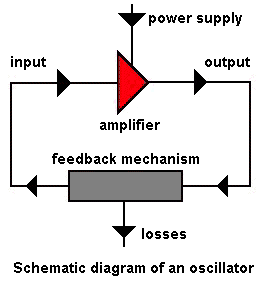

In a laser, the amplifier is the amplifying medium and the supply of power to the amplifier is accomplished by pumping. In any oscillator, a portion of the amplifier output is fed back to the amplifier input in such a way as to reinforce the signal at the input. This is described as positive feedback and, in a laser, it is accomplished by the cavity mirrors that reflect the beam back into the amplfying medium. In general, there will be some loss of power associated with the mechanism of feedback. In a laser such losses arise from less than complete reflection at the mirrors, scattering of light at optical surfaces and diffraction (spreading) of the beam. Included in these losses will be the output of the laser.
The gain of an amplifier is not constant and, in general, it becomes smaller as the magnitude of the input increases. When the magnitude of the input is such that the losses associated with the feedback mechanism are just compensated by the gain of the amplifier, the oscillator operates in a stable manner.
Oscillators do not generally require that a signal be fed into the amplifier to initiate oscillation. Oscillations are usually initiated by 'noise' that is amplified by the amplifier and then fed back to the input. In the case of a laser, this noise has its origin in the random spontaneous emission of light within the energized amplifying medium.
Usually, the feedback mechanism is configured so that one particular frequency is fed back more effectively than others. In a laser, this is done by using mirrors that have high reflectivity at the wavelength at which the laser is intended to operate. It isn't essential that wavelength selective mirrors be used and, in practice, it is often a consequence of the fact that highly reflective, low absorption dielectric coated mirrors are intrinsically wavelength selective. In wavelength tunable lasers, the operating wavelength is often chosen by controlling the wavelength that is fed back into the amplifying medium. This can be done by using a reflecting diffraction grating or a prism in conjunction with a mirror in place of the normal totally reflecting cavity mirror. Tunability over a wide range of wavelengths is only possible if the amplifying medium is able to amplify over a broad band of wavelengths.